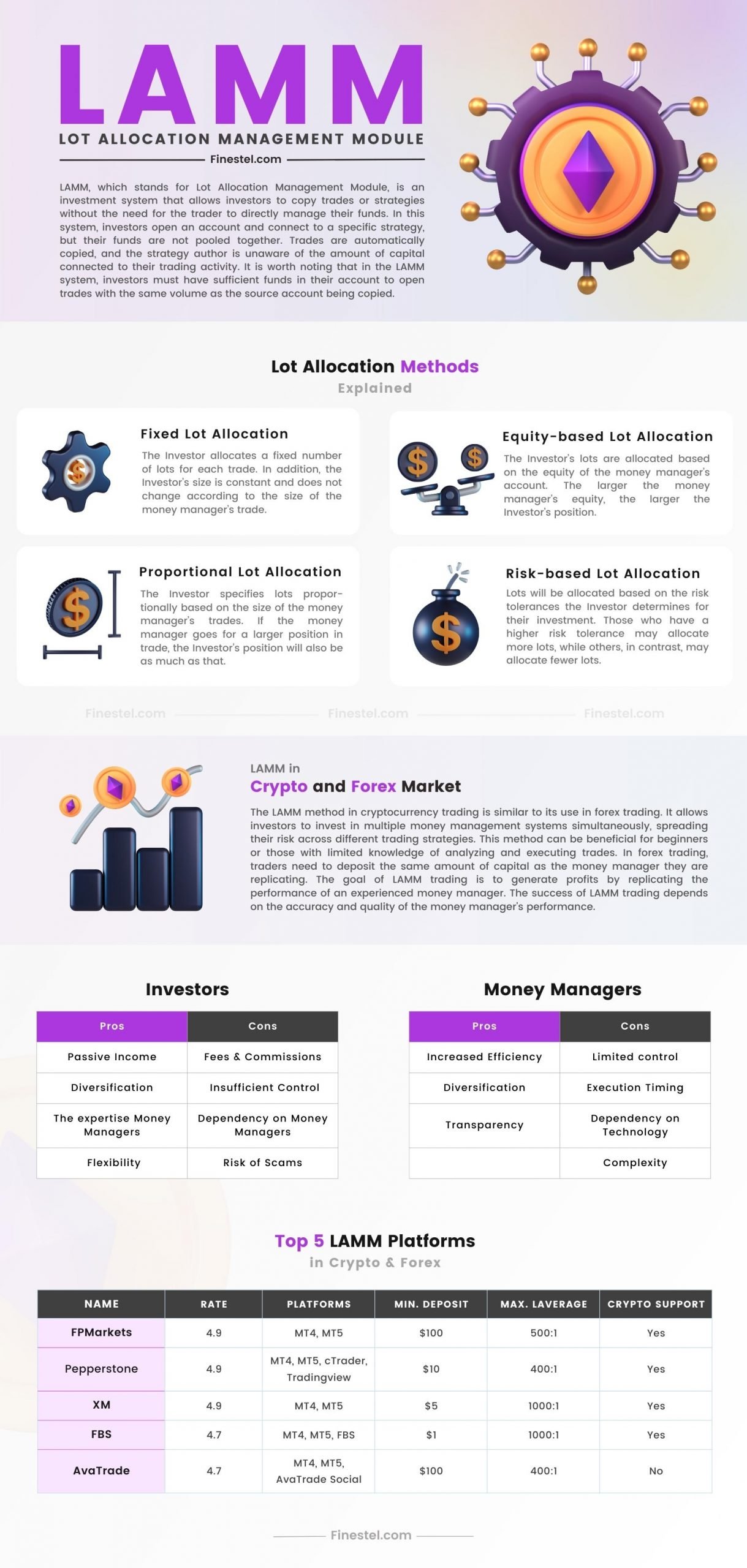In every corner of the trading world, traders may use various strategies and tools to utilize their trading performance. One may choose the LAMM trading method in their specific market to earn potential money. LAMM works as a passive way to achieve benefits via a central account managed by a money manager or professional trader.
In this article from Finestel’s Academy, we will discuss what LAMM is, how it works in cryptocurrency trading and Forex market, its pros and cons, and its distinction from PAMM, MAM, and other similar trading methods.
What is LAMM?
LAMM, an abbreviation of Lot Allocated Management Module, is a trading method that allows investors to allocate a defined amount of lots for their trading. LAMM existed before PAMM (we introduce it further in the article). Notably, LAMM is only sometimes implemented by traders or suggested by forex brokers to traders.
Investors have enough flexibility in LAMM trading to define the number of lots they want to invest for trading and conclude about a replication ratio by designating the money invested for each trade. Through this act, investors can choose different leverage levels and risk tolerances. Any replication ratio the Investor selects will be the basis for calculating LAMM’s profit or loss.
How Does LAMM Work in the Context of Crypto Trading?
In cryptocurrency trading, the LAMM method works the same as its operations in the forex trading environment, meaning that crypto investors can simultaneously invest in multiple money management systems to spread their risk among various trading strategies. It can benefit beginners or those with insufficient knowledge of analyzing and executing their trades.
In the cryptocurrency market, there are third-party providers which present platforms for LAMM trading. Investors and Traders can connect to each other through those platforms and start their trading operations. These third-party providers, also known as technology providers for the two parties in the trading field, act for the LAMM method in the context of crypto trading, along with solving some challenges and concerns such as timing, sub-account connection, multiple exchange connection, and so on.
LAMM in Forex Market
LAMM is applicable in cryptocurrency as it generally has roots in the forex market. In the forex market, a trader should deposit the same capital as the money manager. For instance, if the money manager manages a $2,000 account, traders must also have a $2,000 account.

Generating profits by replicating the trading performance of an experienced money manager is the initial goal of LAMM trading in the forex market. It allows investors to earn profits easier without presently participating in the analysis and trading processes. Any profit or loss in LAMM trading directly depends on the accuracy and quality of the money manager’s performance.
Explaining Lot Allocation Methods
In the LAMM method, the methods of lot allocation are core factors in determining the replication ratio and the amount of money allocated for each trade. Various methods of lot allocations are as follows:
Fixed Lot Allocation: The Investor allocates a fixed number of lots for each trade. In addition, the Investor’s size is constant and does not change according to the size of the money manager’s trade.
Proportional Lot Allocation: In this method, the Investor specifies lots proportionally based on the size of the money manager’s trades. If the money manager goes for a larger position in trade, the Investor’s position will also be as much as that.
Equity-based Lot Allocation: In this method, the Investor’s lots are allocated based on the equity of the money manager’s account. The larger the money manager’s equity, the larger the Investor’s position.
Risk-based Lot Allocation: In this method, lots will be allocated based on the risk tolerances the Investor determines for their investment. Those who have a higher risk tolerance may allocate more lots, while others, in contrast, may allocate fewer lots.
Investors should carefully consider methods to find the proper one that aligns with their investment goals and risk tolerance.
Pros & Cons of LAMM for Crypto Traders and Investors
Any trading method has its pros and cons. Let’s take a look at them in detail, separated for investors and money managers.
For Investors
Pros
- Passive Income: LAMM trading makes it possible for investors to earn money passively by replicating the trading performances of professional money managers. This procedure is incredibly lucrative for those who do not need more time or expertise for active trading.
- Diversification: By investing in multiple streams of money managers, LAMM trading allows investors to diversify their portfolios and spread the risk amidst various trading strategies. This act can help them to mitigate the influence of potential losses.
- The expertise of Money Managers: LAMM trading meets the needs of investors with the expertise of professional money managers. Investors can leverage their professionals’ knowledge and experience to make more money as a profit.
- Flexibility: LAMM Trading allows investors to arbitrarily define the replication ratio and amount of lots they desire to trade.
Cons
- Dependency on Money Managers: LAMM trading needs investors to rely on the quality and performance of money managers. If these copied individuals make poor trading decisions or losses, the Investor’s account takes effect negatively.
- Insufficient Control: Since the Investor has granted the decision will of trade with allocated lots in the hands of the money manager, logically, LAMM trading limits their control over the trading process. According to that, investors can not actively make decisions or adjustments for their traders. (less or more based on their chosen Lot Allocation methods)
- Fees and Commissions: Money managers generally receive commission fees from Investors participating in LAMM trading. These fees are usually a shared part of generated profits (AKA performance fee). Considering these fees in calculations of ROI is vital for investors.
- Risk of Scams: According to the nature of LAMM trading, there is a risk of facing scams or unreliable money managers who exaggerate their statements. Investors should conduct their in-depth research and choose reputable brokers and money managers.

For Money Managers/Traders/Asset Managers
Pros
- Increased Efficiency: LAMM trading allows money managers to execute trades on behalf of several investors, deletes the need for manual trading on those accounts, and increases efficiency and time savings.
- Diversification: Money Managers spread their trading performance across multiple accounts to better diversify investment strategies.
- Transparency: Money Managers and their clients can track performance and monitor trades since LAMM trading platforms often offer real-time reporting and transparency.
Cons
- Limited control: in LAMM trading, money managers must adhere to the allocation ratios and strategies agreed upon, meaning that they have limited control over their client accounts.
- Execution Timing: Simultaneous execution of LAMM trades across multiple accounts may experience variations in order execution. It leads to different entry-to-exit prices for each investor’s account.
- Dependency on Technology: Technology is the core of LAMM trading. Any technical issues, system downtime, or network interruptions can disrupt trading activities and potentially impact performances.
- Complexity: Money managers admit that LAMM trading needs a deep understanding of the broker’s features, allocation methods, and risk management techniques. This complexity requires the money managers to ensure their qualifications in utilizing LAMM trading strategies.
LAMM vs. Copy Trading
Although LAMM trading and copy trading are both passive methods to achieve benefits in the cryptocurrency market, there are some magnificent differences between these two which are explained in the following table:
| LAMM Trading | Copy Trading |
|---|---|
| Investors can adjust the replication ratio and specify the capital involved for each trade. | In some platforms, Investors can adjust the replication ratio, and in others, they can NOT. |
| Investors can invest in several money managers to diversify the risk | In some platforms, Investors can only copy the trades of a single trader, and in some others, they can use multiple exchange accounts and sub-accounts. |
| It requires the trader to deposit the same amount of money as the money manager | It does NOT require the investor to deposit the same amount of money as the trader |
| Money managers receive commissions (performance fee) from investors as a shared part of the profit they make | Investors may or may NOT pay commission fees (performance fee) to the trader |
| LAMM trading is NOT as widely offered by cryptocurrency brokers | Copy trading is more ordinarily offered by cryptocurrency brokers |
What are the Differences between MAM, PAMM, and LAMM?
Besides the LAMM, there are two other trading methods: MAM (Multi-Account Manager) and PAMM (Percentage Allocation Management Module). These methods have a familiar concept, but the key differences between MAM and PAMM are as follows:
MAM
MAM is a trading method that allows money managers to manage multiple trading accounts concurrently. In MAM, the money manager’s trades are executed across all accounts under management while maintaining the same positions and proportions. MAM trading presents greater control and transparency for investors compared to LAMM trading.
In a nutshell, MAM is the equal concept of copy trading.
PAMM
PAMM is also a method of trading that allows investors to allocate a certain percentage of their money to a money manager whose trades are executed proportionally based on the allocated percentage. PAMM trading offers investors more flexibility about investment amounts than LAMM trading.
Profit Distribution in LAMM
Profit distribution is a crucial aspect to consider in LAMM trading since when the money manager generates a profit, the Investor also benefits from the profits. Correspondingly, if the money manager makes losses, the Investor will also receive damage.
The profit distribution will be determined according to the methods mentioned above of replication ratio and the lot allocation the Investor chooses. It is essential for investors to thoughtfully consider their risk tolerance and investment goals at the time of choosing the replication ratio.
Read more about copy trading vs. PAMM.
Top 5 LAMM Platforms in Crypto & Forex
The following table compares the top 5 LAMM platforms for the Forex market:
| Name | Rating of 5 | Platforms | Min. Deposit | Max. LEvErage | Crypto support |
|---|---|---|---|---|---|
| Fpmarkets | 4.9 | MT4, MT5 | $ 100 | 500:1 | YES |
| Pepperstone | 4.9 | MT4, MT5, cTrader, Tradingview | $ 10 | 400:1 | YES |
| XM | 4.9 | MT4, MT5 | $ 5 | 1000:1 | YES |
| FBS | 4.7 | MT4, MT5, FBS Trader | $1 | 1000:1 | YES |
| AvaTrade | 4.7 | MT4, MT5, AvaTrade Social | $ 100 | 400:1 | NO |
LAMM in Crypto Trading Infographic
Conclusion
LAMM, or Lot Allocated Management Module, is a trading method that allows investors to earn money passively by replicating the trades of skilled money managers. It allows investors to choose the number of lots they want to trade and the replication ratio.
While LAMM trading offers several advantages, such as passive income and diversification, it also has risks and limitations. Investors should consider their risk tolerance and investment goals before engaging in LAMM trading.
FAQ
What is LAMM in the context of crypto trading?
As LAMM in the crypto market, investors can simultaneously invest in multiple money management systems to spread risk among various trading strategies.
How does profit distribution work in LAMM?
Profit distribution In LAMM is generally proportional to the individual investments made by participants meaning that each participant receives a portion of the profits regarding their primary investment percentage.
How does LAMM differ from PAMM and MAM in crypto trading?
LAMM focuses on the proportional allocation of positions based on investment size, while PAMM allocates funds based on a percentage of the total account value. MAM allows an account manager to execute trades on behalf of multiple accounts simultaneously.
What should I consider before choosing a LAMM service for crypto trading?
Before choosing a LAMM service for crypto trading, consider the trader’s trading history, reputation, fees, risk management practices, control over funds, and terms and conditions.
What are the key differences between using LAMM in Forex trading versus cryptocurrency Trading?
In a sentence, Despite the assets being traded, LAMM in Forex focuses on traditional fiat currencies, while cryptocurrency trading involves digital currencies and assets. In addition, the volatility and market dynamics associated with each asset class can vary magnificently.






Leave a Reply